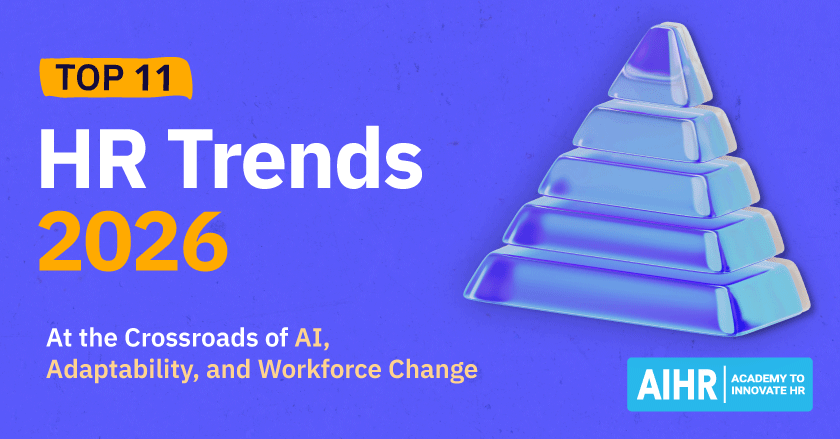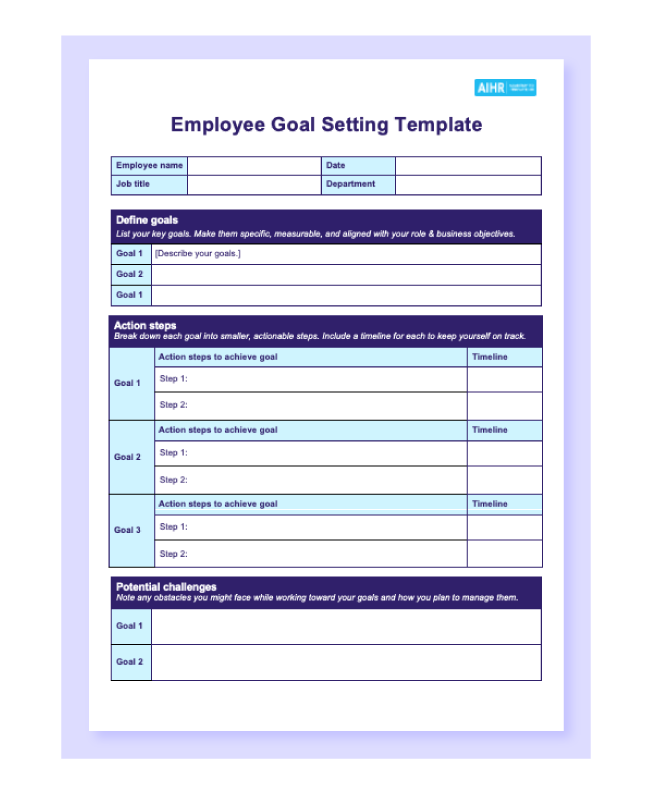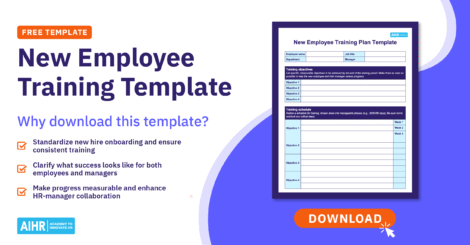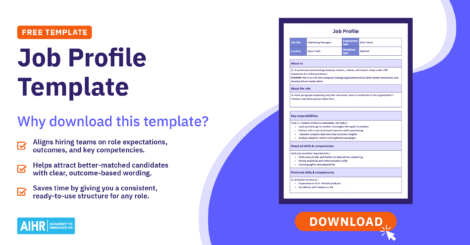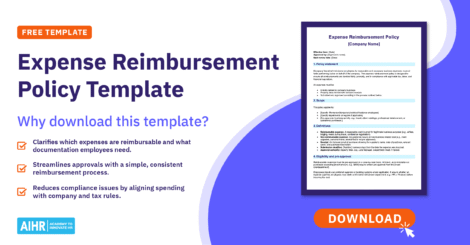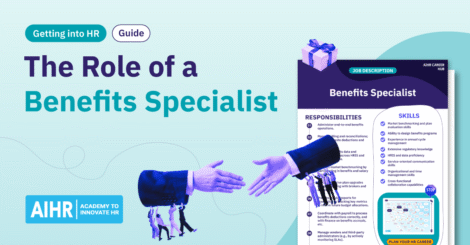An employee goal setting template helps align individual aspirations with company objectives, leading to a more focused and motivated workforce. Those who set specific and challenging goals perform up to 90% better than those with easy or vague goals, because well-defined goals provide clarity and direction.
This article discusses employee goal setting, HR’s role in it, how to use an employee goal setting template, and how HR can help employees set clear goals.
Contents
What is employee goal setting?
The challenges of employee goal setting
Why use an employee goal setting template?
7 key elements of an employee goal setting template
Free employee goal setting template
9 examples of employee goals
How HR can help set effective employee goals
What is employee goal setting?
Employee goal setting is the process of creating clear, measurable objectives for employees. These goals help each person understand how to be successful in their tole. Effective employee goal setting provides focus, direction, and a clear path for growth.
The main purpose of employee goal setting is to align individual goals with overall company objectives. When employees know how their work contributes to the bigger picture, they’re more motivated and productive. It also helps managers track performance and make better decisions about development and rewards.
HR’s role in employee goal setting
Employees who set performance goals are more likely to feel inspired at work, but 31% of employees say their managers haven’t helped them set such goals. This highlights the need for HR to step in and provide the right structure, tools, and support. The aspects of HR’s role in employee goal setting include:
- Establishing a goal setting framework: Helps aligns goals with business objectives. HR defines SMART goals and integrate them into performance systems.
- Providing training and resources: HR offers workshops, coaching sessions, and online courses to ensure everyone knows how to set effective goals.
- Facilitating regular check-ins and performance reviews: These help assess progress, adjust targets, and offer feedback, keeping goals relevant and on track.
- Ensuring fairness, inclusion, and transparency: HR standardizes expectations across departments in order to eliminate biases and ensure a fair process.
- Using technology to streamline goal tracking: HR uses goal-tracking software that lets employees and managers set, track, and adjust goals efficiently. Real-time data from these tools helps in making informed development decisions.
The challenges of employee goal setting
Common challenges associated with employee goal setting include unclear objectives, lack of motivation, and misalignment with company goals,
If goals are too vague or overly complicated, employees won’t know what’s expected of them. This makes measuring progress difficult, leading to confusion, disengagement, and job dissatisfaction. Employees need a detailed roadmap to help them stay focused and prioritize their tasks effectively.
Goals should also be meaningful and achievable, or employees will feel less motivated to pursue them. If goals are unrealistic or don’t align with personal growth, employees may even disengage. Lack of feedback or recognition can also make goal setting feel like just another box to tick rather than a tool for real progress.
Additionally, if individual goals don’t connect with business objectives, teams can end up working in different directions. This misalignment leads to inefficiencies, wasted effort, and missed opportunities. Employees must see how their work contributes to the bigger picture to help them stay engaged and effective.
How structured goals help overcome these challenges
A well-structured goal setting framework ensures objectives are clear and aligned with company priorities. HR SMART goals, for instance, can provide clear direction and make progress easier to track.
Scheduling regular check-ins to offer feedback and review goals can keep employees engaged, help them adjust their approach, and ensure they’re on the right track. When OKRs connect their efforts to business success, they can also gain a stronger sense of purpose.
Employee recognition and rewards are vital, too. Celebrating achievements, big or small, builds a culture of continuous improvement and boosts employee morale, motivation, productivity, and satisfaction.
Why use an employee goal setting template?
Firstly, it takes the guesswork out of setting goals by providing a clear framework that outlines specific objectives, timelines, and KPIs. This makes it easier for employees to focus on actionable steps instead of having to figure out where to start.
A structured, standardized template also ensures fairness and consistency across all departments and teams. Managers can evaluate performance more objectively, compare progress across departments, and make sure every employee’s goals contribute to the company’s broader mission.
Also, a goal setting template helps employees and managers monitor milestones and make data-driven adjustments. With clear checkpoints, employees can track their progress, identify obstacles, and refine their approach. This helps HR and leadership make informed decisions on promotions, training, and performance development.
Finally, a template provides a visual representation of progress, reinforcing a sense of achievement. Employees are more likely to stay committed when they can see how far they’ve come. It also helps managers provide timely feedback, support, and employee recognition, ensuring staff stay engaged and motivated.
Build your skills in helping employees set effective goals
Learn how to facilitate an efficient employee goal setting process to improve employee motivation and retention, and set your organization up for long-term success.
AIHR’s Talent Management and Succession Planning Certificate Program teaches you how to identify, develop, and engage future leaders, as well as modern talent mobility practices that enable you to help employees advance in their careers.
7 key elements of an employee goal setting template
Before you start developing or using an employee goal setting template, familiarize yourself with the following seven key elements you should include in your template:
- Clear objectives: Before anything else, the template should enable employees to detail well-defined, specific goals. This prevents ambiguity and makes it easier to track success.
- Action steps: These help employees understand how to achieve their goals. Breaking a larger goal into smaller, manageable tasks, for instance, makes progress more achievable and provides an execution roadmap.
- Timelines: Setting timelines and deadlines for each goal and its corresponding action steps ensures employees stay on track.
- Progress tracking: Regularly reviewing progress helps employees stay accountable. The template can provide a visual representation of milestones reached and areas that need improvement, making adjustments easier if needed.
- Potential challenges and obstacles: This helps employees anticipate setbacks and plan effective strategies to overcome them, keeping their goals realistic and achievable.
- Support/resources needed: On the template, employees should note what resources, training, or mentorship programs they need to succeed. Outlining these needs ensures they have the right tools to accomplish their goals.
- Evaluation of goal completion and success: At the end of the goal period, employees and managers should assess if goals were met, what worked, and what didn’t. This helps refine future goal setting and continuous learning and development.
Free employee goal setting template
AIHR has created a free, customizable employee goal setting template to help you and your workforce streamline the goal setting process, from defining objectives to tracking progress.
9 examples of employee goals
Below are nine types of employee goals individuals within your workforce will have to set at different points of their careers and professional development:
Example 1: Performance goals
Performance goals are about improving productivity, efficiency, and job-specific skills. They keep employees focused and ensure they’re delivering their best work. These include:
- Increase sales by 15% in six months by refining sales techniques
- Complete project deliverables ahead of schedule by staying organized
- Reduce report errors by 20% through careful review and workforce automation.
Example 2: Collaboration goals
Collaboration goals help employees build stronger relationships with their team members, leading to smoother workflows and better results. These include:
- Improve communication by actively joining team check-ins
- Lead a cross-department project
- Mentor a new team member.
Example 3: Development goals
Development goals help employees expand their professional knowledge and abilities so they can advance in their careers. These include:
- Earn an industry certification in a relevant field
- Attend three professional workshops
- Improve proficiency in new software through an online course.
Example 4: Leadership goals
Employees who want to develop leadership competencies can set relevant goals, such as:
- Lead a major project to gain decision-making experience
- Mentor junior employees
- Enhance delegation skills to improve team efficiency.
Example 5: Personal growth goals
These goals focus on soft skills and self-improvement to make employees more confident and adaptable at work. These include:
- Improve time management with techniques like the Pomodoro Technique
- Build resilience using stress management techniques
- Boost public speaking skills by joining a club or volunteering for presentations.
Example 6: Innovation goals
Innovation goals encourage employees to push boundaries, solve problems creatively, and drive business improvements. These include:
- Propose and implement a workflow improvement that saves time or cuts costs
- Develop a fresh marketing campaign
- Experiment with new technologies to boost efficiency.
Example 7: Customer service goals
Useful for employees in customer-facing roles, these goals focus on improving the customer experience, increasing satisfaction, and building loyalty. They include:
- Reduce customer inquiry response time by 20%
- Increase positive feedback by listening carefully and providing better solutions
- Enhance product knowledge for improved support.
Example 8: Operational efficiency goals
These goals focus on streamlining processes and reducing inefficiencies, helping teams work smarter, not harder. They include:
- Automate repetitive tasks
- Cut production errors by improving quality control
- Identify cost-saving opportunities to optimize budgets.
Example 9: Networking goals
Networking goals help employees expand their professional circles and create opportunities for learning and career advancement. They include:
- Attend at least two industry conferences per year
- Grow your LinkedIn network by 50 connections
- Participate in company networking events to build internal relationships.
How HR can help set effective employee goals
HR plays a key role in ensuring employee goal setting is structured and results-driven. By using the right goal setting template and encouraging active participation, you can create an environment where employees feel empowered and engaged. Here’s how to make the process more effective:
Align individual goals with company objectives
Employee goals should support the organization’s broader vision. When employees understand how their work contributes to business success, they feel more motivated and purposeful. A structured goal setting template helps define objectives clearly, making alignment easier and progress measurable.
Involve employees in the goal setting process
Employees are more engaged when they have a say in their own goals. Encourage managers to collaborate with their teams, setting objectives that are challenging but meaningful. When employees feel ownership over their goals, they’re more likely to stay committed to achieving them.
Use free goal setting software to track progress
Digital tools can simplify employee goal setting and tracking. Free platforms like Trello, Asana, and ClickUp provide interactive goal-setting charts that can help employees visualize their progress and stay accountable.

Review and adjust goals regularly
Goals shouldn’t be static. Have quarterly check-ins to assess progress, provide feedback, and adjust goals as needed. This ensures employees stay on track while adapting to changing business needs.
Provide support and resources
Employees need the right support in order to meet their goals. Provide access to training, online courses, continuous feedback, and user-friendly tracking tools to help them overcome challenges, stay on track, and continuously improve their performance.
Celebrate achievements to maintain motivation
Recognize accomplishments (e.g., through team shoutouts, bonuses, or promotions) to help reinforce a culture of growth. Be sure to acknowledge even small wins, as this can boost morale and keep employees engaged.
To sum up
Clear and specific goals boost performance and align work with company targets. A good goal setting template gives employees a clear plan with actionable steps and milestones, while HR provides training, resources, and regular feedback.
Structured goal setting tackles challenges like vague objectives and low motivation. With fair processes and ongoing support, you help employees reach their goals, driving productivity and success.


